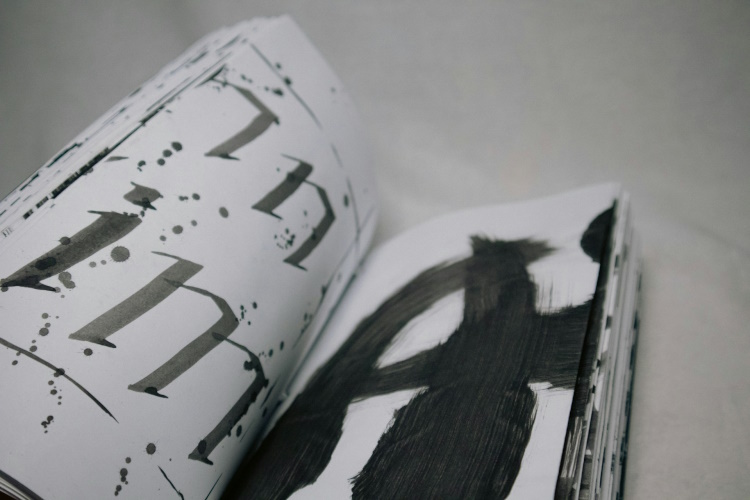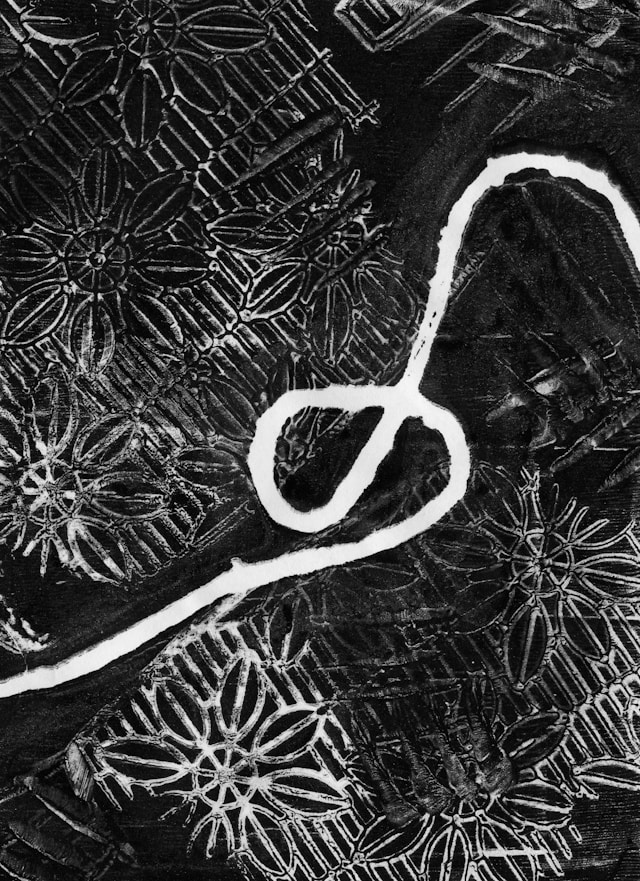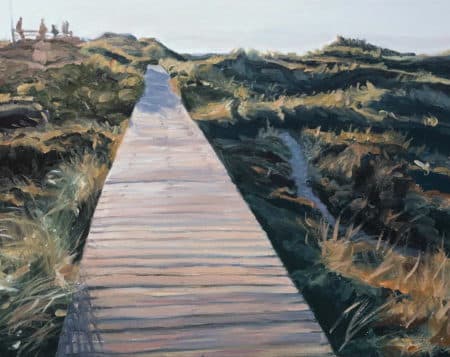In the 1950s, Andy Warhol worked as an advertising graphic artist and looked for ways to produce his illustrations faster and more efficiently. His solution was as simple as it was brilliant: handmade rubber stamps with which he brought recurring patterns and symbols into his works. Especially for his clients at I. Miller & Sons Shoes, he developed a stamping technique in 1955, which allowed him to create diverse illustrations and to quickly vary colors and compositions. This “machine -like” way of working, as Warhol later called it, already showed his fascination for serial image production .
What Warhol developed at the time, we now know as a "blotted line technology" -a method that connects and prints in a surprisingly accessible way. This technology combines drawing elements with simple printing processes and enabled Warhol to make numerous illustrations on a related topic. Every pressure becomes unique, although the technology enables repetitions.
The nice thing about it: you only need a few materials - watercolor paper, ink and transfer paper are sufficient. The process itself is very simple: a picture is traced on transfer paper and then pressed on watercolor paper. This creates the characteristic inkprint that makes Warhol's early work unmistakable. His illustrations of birds, butterflies and flowers for advertising purposes gave this technology to their playful and at the same time professional character.
Warhol's influence on the monoprint technology
What role does repetition play in art? "
Warhol already asked this question years before his screen prints made him famous. His early experiments with Monoprint technology laid the foundation for an artistic philosophy that should fundamentally question the relationship between original and copy.

photo by Josué as @yehoshuaas, via Unsplash
Initially, Warhol drew inspiration from newspaper advertisements and tabloid photographs, which he copied by hand. However, he soon became more fascinated by photomechanical processes than by expressive brushstrokes. His paintings were intended to resemble commercial products – smooth, impersonal, and reproducible. Mass production and the omnipresence of consumer culture became his central theme. He transformed everyday objects into iconic symbols through serial repetition; the assembly-line mentality of the consumer goods industry was directly reflected in his working method.
His technical approach was amazingly direct. For the famous Marilyn Monroe series, which he showed for the first time three months after the actress's death in November 1962, Warhol transferred an enlarged advertising photo to fine-meshed tissue and printed it on canvas. The subsequent revision with contrasting pastel tones produced the artificial, mask-like effect that made Marilyn a pop icon.
Warhol's work organization was also remarkable. According to his instructions, assistants such as Gerard Malanga, Ronnie Cutrone and George Condo produced countless variations of his motifs. Art as a teamwork , as a conceptual process - this idea was radical at the time. The screen printing itself, in which ink is transferred to the surface through a network, provided the desired strong, flat colors and clear contours.
Over the years, Warhol's motifs became less dramatic. Flowers, soup cans, plane tickets - banal objects, which he provided with unexpected colors and thereby sparkled humorously. His early monoprint experiments had taught him how commercial printing techniques can become artistic statements.
That was his real legacy: to blur the boundaries between mass production and artistic expression and to show that art can be democratic. ”
This is how the Blotted line technology works
If stamps are generally talked about in Germany, one or the other first pictures of authorities and typical notary stamps made of light wood with a blue stamp pillow come to mind. But if you spans the mental arc wider and take the artistic-creative field in, then you discover a wealth of exciting techniques and creative approaches-often under the roof term "Stamping" .

Image by Heather Green @Heathergreengreen, via unsplash
Warhol, for example, developed his Blotted Line technology during his studies at the Carnegie Institute of Technology and refined her into an efficient tool for his advertising orders in the 1950s. The special thing: This method creates characteristic broken lines with random ink blobs - an effect that made Warhol's early illustrations unmistakable.
The material list is surprisingly short:
- Transparent paper
- Character box or absorbent paper
- Ink or ink
- Fuller, ink chopper or toothpick
- Pencil
- tape
The process begins with a pencil sketch on transparent paper. This is attached with adhesive tape next to a leaf more absorbent paper - both leaves can be folded on one another without slipping.
Now it will be exciting: Individual sections of the pencil drawing are followed by ink. As long as the ink is still damp, you fold the absorbent paper on it and gently stroke over it. When folding back, the impression shows - the eponymous "Blotted Line" . This process is repeated piece by piece until all lines are transmitted.
What makes this technique so attractive? The lines varied, ink blobs and defects arise as by itself. Warhol then often colored its prints with watercolor paints or gave them additional depth by gilding.
The transparent paper should be kept - it can be used for further prints. Each new reprint will look slightly different, which makes up the charm of the monoprint.
For Warhol as a advertising graphic artist, this technology was worth gold: he was able to reproduce a template in several variants and experiment with different colors. He offered his customers different versions of the same motif - an early form of his later serial image production.
In the following video you can see yourself how a teacher of the Andy Warhol Museum presents the Blotted line method, which Andy Warhol often used in his commercial works in the 1950s:
The Andy Warhol Museum is located in Pittsburgh, Pennsylvania, the hometown of Andy Warhol, and preserves the most extensive collection of his works of art and archive stocks. It is one of the world's most comprehensive museums that are devoted to a single artist and is the most important of its kind in North America.
See this post on Instagram
In the second video, Warhol's stamping technology ( Rubber Stamping Technique ) is shown, which Andy Warhol often used in his commercial projects and in his early works of art in the 1950s. This method played Warhol in a playful way to generate recurring motifs and symbols such as birds, butterflies, fruits and flowers.
Tips for modern monoprinting projects
The good news in advance: Modern monoprinting projects need surprisingly little equipment. A non-absorbing panel made of glass or plexiglass, pasty colors such as acrylic paints or water-based printing inks, a color roller and high-quality paper-no more is necessary. There are also various tools for manipulating the color, depending on which effects you want to achieve.
An essential technical note: Work for printing in CMYK color mode , as RGB colors can lead to unwanted color shifts. A resolution of at least 300 dpi ensures clear, sharp results.
Three basic variants lead to unique monoprints. The first method: Apply the color to a glass plate and draw the motif on the back of the paper put on it. Alternatively, place plant material on the colored plate, cover it with copy paper and rub the color around the plant parts away. The third variant works with stencils, whereby the color is applied directly to the paper.
Gel plates for fine structures are particularly attractive. They are ideal for material prints or template work. An attractive effect arises when you remove all plants "ghost print"
Frequent beginners' errors can be easily avoided: do not forget the cropping benefits and safety distances. A cut of about 5 mm around your work area prevents white edges. Central elements such as texts or logos need at least 3 mm safety distance.
The surprise moment is the special charm of monoprinting - only when the paper is lifting off the pressure plate is the result. This unpredictability transforms every pressure into a unique work of art and opens up endless opportunities for experimenting.
In the following video you can observe a mono print with the technology that Andy Warhol used as an illustrator. Amy Lindahl , expert in art integration and Steam educator as well as interdisciplinary CTE teacher, published a small time-lapse video:
See this post on Instagram
What remains of Warhol's discovery?
Warhol's Blotted-Line technology was more than just a practical trick for everyday work by an advertising graphic artist. It became the starting point for an artistic attitude that was supposed to shape the 20th century. Here it was already clear what his trademark would later be: the connection between industrial production and artistic expression.
The special thing about this early phase is how Warhol converted commercial necessities into artistic possibilities. His clients wanted quick variations of their motifs - Warhol recognized the potential of the series. Its customers needed inexpensive solutions - he developed a technology that worked with the simplest means. What started as a practical solution became an aesthetic philosophy.
Today, more than 70 years later, the monoprint technology has lost none of its attraction. It stands for something that has become precious again in the digitized art world: the unpredictable, the handmade, the unique. Every pressure tells its own little story - through an ink blob here, an unexpected line there.
Warhol's early experiments still show us today that significant art does not have to arise from expensive materials or complicated procedures. Sometimes transparent paper, ink and a little joy of experimentation are enough. His message was as simple as it is clear: art should be accessible, feasible for everyone, democratic. This attitude goes through his entire work-from the first shoe illustrations to the late Polaroid series.
Anyone who uses blotted line technology today combines with this tradition of creative pragmatism. You discover the joy of unexpected and learn that control and chance can be the ideal partners in the artistic process.

Owner and Managing Director of Kunstplaza. Publicist, editor, and passionate blogger in the field of art, design, and creativity since 2011. Successful completion of a degree in web design as part of a university program (2008). Further development of creativity techniques through courses in free drawing, expressive painting, and theater/acting. Profound knowledge of the art market through many years of journalistic research and numerous collaborations with actors/institutions from art and culture.

















